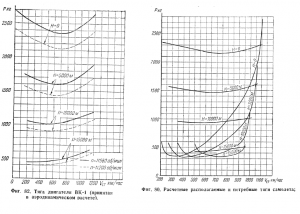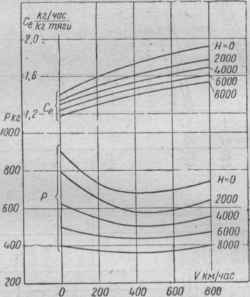涡轮喷气式发动机
阅读
2020-06-04更新
最新编辑:Moy_Official
阅读:
更新日期:2020-06-04
最新编辑:Moy_Official
涡轮喷气发动机的速度特性依据于发动机速度控制原理中有关发动机功率取决于在恒定H(高度)下的真实M(马赫-音速)空速值的依赖性的部分。因此,当我们需要调节以具有固定流道形状为特点的早期涡轮喷气发动机转速时,唯有通过改变燃料消耗速率的方式,才能对其进行有效控制。故而可知,速度的控制是通过保持发动机转速的稳定和离开燃烧室的气体温度恒定来实现的。
涡轮喷气发动机的典型速度特性可以在图1和2(VK-1和Jumo 004B)上看到。图表显示,当飞行速度提高时,推力先减小,然后增加,然后在М(Mach)2 ... 4处再次降至零。这种类型的推力变化取决于涡轮喷气发动机某些主要参数的变化:压力增加的程度,空气消耗,单位推力等。 涡轮喷气发动机的单位推力(Rsp,图3)随着飞行速度的提高而不断减小,因为它由废气流速度和飞行速度之差来确定。当两者相等时,显然,发动机不会产生推力。
压力的增加和与之相关的大规模气流(Ga,图3)随着速度的增加而增加(速度越高,由于动态压力,更多的空气会流经发动机)。在低速飞行时,压力和气流的增长微不足道,但随着速度的增加而变得更高(该关系接近于二次方)。
As a result, the thrust of the turbojet has several specific characteristics – at low speeds, the thrust is reduced to speeds of approximately 0.5...0.6 of М (Mach) because of the faster reduction in unit thrust in relation to the rise in pressure, and then the thrust grows as a result of the faster growth in pressure and airflow, after this the thrust again falls to zero.
The engines of most early jet aircraft were located inside the body of the plane due to their great size in comparison with the aircraft itself. This resulted in additional difficulties with supplying air to the engine. Also, a significant proportion of compressed air was taken after the engine compressor for supplying pneumatic systems and devices and maintaining a constant air pressure in the pressurized cockpit. Power from the engine was also used for oil pumps and electricity generators. All of these additional factors lead to a reduction in the thrust of the engine installed on an aircraft in comparison to the thrust obtained on a test bed which is usually what is written in reference books. For example, the thrust of the VK-1 engine of the MiG-15bis is 2500 kg at a speed of zero at sea level, while when the same engine is on a test bed under the same conditions, it has a thrust of 2700kg (see fig.1). In flight, due to the decrease in unit thrust at small speeds, the thrust of the VK-1 installed in an aircraft decreases to 2150 kg at sea level, which is 80% of its thrust when it is static on a stand.





 沪公网安备 31011002002714 号
沪公网安备 31011002002714 号